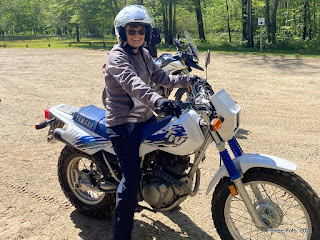I accompanied my husband Mark and two friends (Larry and Justin) on their dirt bike riding trip to Michigan. While they rode motorcycles and quads, I hiked the beautiful Michigan forests.
The first day (June 11, 2021) we arrived at Sleepers Heaven cabin near Petoskey, MI in the afternoon. We stayed in the green cabin, which is set up for hunters, motorcyclists, and snowmobilers. The cabin is near the Tomahawk moto trails and they could ride to the trails from the cabin.
 |
| Corn Cockle |
 |
| Herb Robert geranium |
The next morning I ventured to McCune Nature Preserve to hike. Such a peaceful, pristine, natural area. I entered a pine-maple forest dense with many ferns. A bird chirped loudly next to me and a chipmunk froze near a fallen log when it saw me. There are also American beech and yellow birch trees here. The sugar maples are so large, they have shaggy bark. A storm must have came through here as I can see its path of destruction.
I sit on a bench along the slow moving sandy bottom, clear stream where forget-me-nots and buttercup grow. Only a few people pass by, and in between I hear a chickadee call "see saw," watch a butterfly, and hear the wind softly whisper in the trees. Listen harder, and I can hear more birds filling the air surrounding me. Next to me a large fallen tree has ferns and fungi growing on its fallen buttress forced from the ground by past tremendous power. Yet, the dainty ferns, fungi, grasses, moss, sedge, and false mayflower gently feed off the dying tree - pulling its energy and life force to start the cycle anew.
After a couple hours of hiking I take another break on another uniquely carved bench along a stream. There is so much to see here - new plants, as well as old favorites. I found a lady slipper, though the bloom was dried. Wild onion and strawberry look good enough to eat. I walk along scotch and white pine; balsam fir; red, striped, and sugar maple; and hazelnut.
There is a bog area with a zigzag boardwalk through it. I carefully skirted around a water snake along the edge. Water plants bloom in the distance. There are different ferns in here: sensitive, broad beech, and possibly marsh fern. I also saw a bluebeard lily, galium, and wild sarsaparilla.One area was dark under the cover of the sugar and red maple trees. Underneath tall, 3-5 foot oak ferns blanketed the ground. I half expected a dinosaur to come around a distant tree n the prehistoric feeling forest.
I am absorbed into this place - one with the plants and nature around me. As the bench I sit on says, "It's OK...No Worries."
I hiked 4.3 miles for 2 1/2 hours. Here are some of the plants and pictures from McCune Nature Preserve.
 |
| columbine |
- Corn cockle (Agrostemma githago)
- Hoary alyssum (Berteroa incana)
- Wild columbine (Aquilegia canadensis)
- Oxeye daisy (Chrysanthemum leucanthemum)
- Alternate leaved dogwood (Cornus alternifolia)
- Blackberry (Rubus allegheniensis)
- Foamflower (Tiarella cordifolia)
- Herb Robert (Geranium robertianum)
 |
| Tiarella |
- Sugar maple (Acer saccharum)
- Red maple (Acer rubrum)
- striped maple (Acer pensylvanicum)
- red pine (Pinus resinosa)
- scotch pine (P. sylvestris)
- white pine (P. strobus)
- eastern hemlock (Tsuga canadensis)
- American beech (Fagus grandiflora)
- yellow birch (Betula alleghaniensis)
- False Mayflower (Maianthemum trifolium)
- wild onion (Alliums sp.)
- wild strawberry (Fragaria virginiana)
- balsam fir (Abies balsamea)
American Hazelnut (Corylus americana)Lady's Slipper Orchid - sensitive fern (Onoclea sensibilis)
- broad beech fern (Phegopteris hexagonoptera)
- marsh Fern (Thelypteris palustris)
- oak fern (Gymnocarpium dryopteris)
- lady’s slipper orchid
- blue bead lily (Clintonia borealis)
- twinberry (Lonicera utaliensis)
- Galium sp.
- wild sarsaparilla (Aralia nudicaulis)
- Rare club moss (Lycopodium abscurum)
- false Solomon seal
- Amelanchier sp.
- Pin Cherry (Prunus serotina)
- forget-me-not (Myosotis scorpioides)
- marsh marigold (Carthage palustris)
Bluebead lily - Yellow water buttercup (Ranunculus flabellaris)
- Indian cucumber root (Medeola virginiana)
- Spring cress (Cardamine bulbosa)
- golden ragwort (Senecio robbinsii)
- COMMON SPEEDWELL (Veronica officinalis)
- Nodding trillium (Trillium cernuum)
 |
| False mayflower |
 |
| Sensitive Fern |
























































